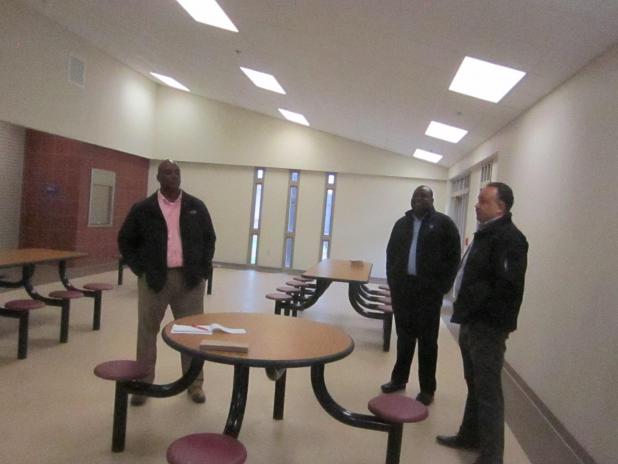
ADMIINISTRATORS OF NEW JUVENILE DETENTION CENTER
Acadiana Center for Youth administrators (from left) Director James Woods, Assistant Director Deroll Barrett and Deputy Director Edward Boyd inspect the dining area of the soon-to-be opened juvenile detention center. {Photos by Raymond L. Daye}
Acadiana Center for Youth getting ready for Nov. 14 job fair
After a few delays, the time is almost here for the opening of the Acadiana Center for Youth -- a juvenile detention center in Bunkie.
Several key positions have already been filled. On Nov. 14 the state Office of Juvenile Justice (OJJ) will hold a job fair from 10:30 a.m. to 6 p.m. in Haas Auditorium.
When fully staffed, the ACY will have 124 employees serving 72 young males (ages 13-21) in a secure environment. Due to budgetary issues, the opening is being phased in. The first 36 youth are expected to arrive in March. The remaining 36 beds should be filled later in the year.
There are positions in administration, social services/treatment, education, direct care, dietary, medical and maintenance.
“Most of the staff will be juvenile justice specialists,” OJJ Deputy Assistant Secretary Beth Touchet-Morgan said. “They will work closely with the youth. They will keep them secure, but also act as a surrogate parent and make sure they run through their routine during the day.”
There will also be teachers for the state-certified school that will operate on the 20-acre campus, social workers to provide specialized programs including group and individual therapy, medical staff and maintenance workers.
ADMINISTRATIVE TEAM
At the top of the center’s organizational chart are its administrators.
James Woods is the director, coming to ACY after serving as assistant director at the Swanson Center for Youth in Monroe.
Edward Boyd is the deputy director and Deroll Barrett is the assistant director.
“I am looking forward to the center opening,” Woods said. “We will take these young men, make them better and send them home to be law-abiding citizens.”
Woods said ACY’s central location will allow families to visit the center’s residents more often, which is deemed to be an important element of the overall rehabilitation program.
ACY will be focused on a therapeutic model intended to treat the offenders for the behaviors that got them into trouble with the law and to prepare them to be productive citizens when they return to their communities.
In addition to middle and high school courses, the education program will include vocational classes and online college classes.
“We will be offering classes from middle school to college,” Touchet-Morgan said. “The school will start the day the first resident arrives.”
The principal is Quentin Calhoun, who has worked at Swanson Center in Monroe and as principal of Ferriday High School in Concordia Parish.
Those attending the job fair will be interviewed and applications will be taken.
About 30 positions will be filled in January. Those in that wave of hirings will be trained and be in position in February, when another 50 employees will be hired and trained in time for the center to open in March.
Touchet-Morgan said the young men sent to a secure facility have been deemed to be “a threat to the public” by the courts.
“We monitor their progress and work with the court system,” she said. “If they make enough progress, they can be released.”
She said an offender can go to court every six months for a progress update.
‘CHANGE THEIR LIVES
’
“This is a way for them to change their lives,” she said.
Most of those in juvenile detention centers have committed violent crimes. Those who have committed murder or other serious offenses are usually handled through the adult criminal justice system.
The residents of ACY could be as young as 13 or as old as 21, if they were a juvenile convicted of a violent crime who has not made sufficient progress to earn release.
“The average stay is 14 months,” Touchet-Morgan said.
The state is trying to reduce the size of its detention centers. Swanson in Monroe and Bridge City in Jefferson Parish are older facilities with large grounds that have had a few hundred residents at a time.
The ACY model is for a smaller campus and fewer residents.
“It is more efficient and more therapeutic,” she said.
Once ACY is fully operational, the plan is to reduce populations at the Monroe and Jefferson Parish sites to “a more therapeutic level.” The Swanson satellite center in Columbia has a capacity of 48.
The state will eventually build replacement centers for Swanson and Bridge City with an 72-bed capacity.
She said the state had seen a 6 percent decline in juveniles sentenced to a secure care facility, and had reduced the number of beds in its existing facilities.
On March 1, a new law went into effect designating 17-year-old offenders to be juveniles. This could add another 60 or so assignments in the state to be handled by the four centers.
She said the state still expects to reduce the number of juveniles in secure care facilities, even with the addition of 17-year-olds.
If the therapeutic approach is successful, juveniles will be incarcerated for shorter periods, which will reduce the number in the facilities.
